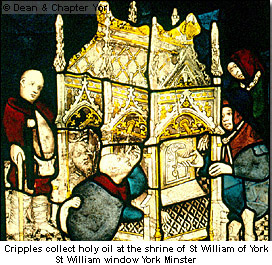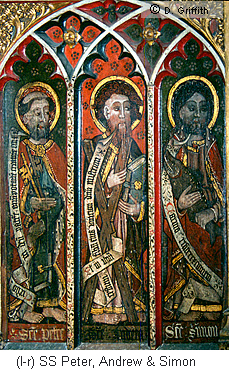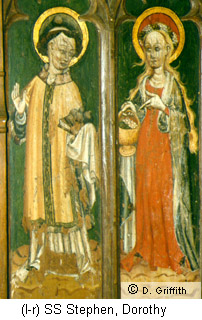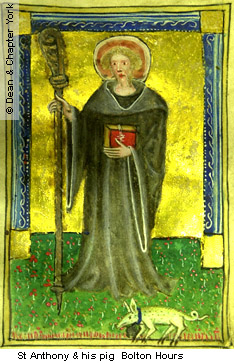
Patterns of Pilgrimage in England c.1100-c.1500
Saints in Medieval Society

Introduction

The saints represented an important resource for the medieval Christian on the pilgrimage of life. Their lives were full of examples of resistance to temptation and evil, and heroic faith and virtue which could teach, encourage and inspire. As intercessors the saints could petition for the spiritual and physical needs of their devotees. The large groupings of saints painted on the dados of rood screens or filling windows and arches of churches offered a visible expression of the 'holy company of heaven' often evoked in medieval wills and perceived as both powerful and approachable. Many of the most famous saints were universal figures, revered across national borders, in contrast to local or national saints, whose cults were restricted. While some of these universal saints were biblical characters, in other cases their origins were obscure and even their lives of dubious historicity.
Saints in the Early Church
The cult of saints traces its origins to the time of the Early Church. The Book of Acts describes the lives of important figures, such as Peter, Paul and Stephen. It records miracles performed by church leaders and also describes the persecution, trials and deaths of the first martyrs. In the early centuries practices such as burial in the vicinity of the tomb of a martyr or the foundation of a church above their grave developed (see Early Christian Tradition: The Cult of the Saints).
Saints in Anglo-Saxon England
The cults of these early Christian saints and martyrs were established in Anglo-Saxon England. In addition many Anglo-Saxon figures were recognised and venerated as saints, particularly those who founded religious houses and those who died either in battle against pagan monarchs or as a result of political intrigue.

Saints in Medieval England
The saints revered in the Western Church during the Middle Ages ranged from the contemporaries of Jesus, apostles and martyrs whose stories are contained in the New Testament, to the often shadowy local saints of the Anglo-Saxon period as well as contemporary figures such as St Zita. Some of these individuals were well-documented historical characters like St Thomas Becket. Others were little more than a name of an early Christian martyr or patron preserved by the dedication of a church. Some of the most famous and popular saints in Western Europe in the Middle Ages were pseudo-historical figures. Little was known of their actual lives but their legends were full of dramatic events and emblematic elements, such as St George killing the dragon.
The Role of Saints in Medieval Society
The Medieval Church recognised and revered a great many saints. These individuals and their cults performed a wide variety of roles in the period 1100 to 1500. Place pilgrimage is a fundamental element in the cult of the saints. People sought physical proximity to a body or relics in the hope that this connection with a saint would bring them help and blessing. Saints in whose cults place pilgrimage played an important role include St Christopher, St Cuthbert, St Edmund, St Edward the Confessor, St Francis of Assisi, St James (Santiago de Compostela), St John of Beverley, St John Schorne, St Julian the Hospitaller, St Thomas Becket, St Thomas Cantilupe, Archbishop Richard Scrope, St Ursula, St William of York, St Wite.

As the phenomenon of place pilgrimage demonstrates, many of the most prominent and popular saints of the Medieval Church were identified with the power to aid their devotees. Saints also exemplified Christian virtues such as faith and charity. Thus the Communion of Saints was regarded as a specific resource for those on the pilgrimage of life. Saints who were particularly important as models and helpers include The Virgin Mary, St Anne, St Barbara, St Christopher, St Elizabeth, St Elizabeth of Hungary, The Fourteen Holy Helpers, St George, St John the Baptist, St Joseph, St Juliana, St Katherine of Alexandria, St Mary Magdalene, St Nicholas, St Sebastian, St Wilgefortis, St Zita.
For those pursuing an inner journey of prayer and contemplation, saints could be seen as models to follow, almost personal mentors. Each religious order looked to its saints to inspire their members. Not only the holy lives but the mystical experiences of saints prompted emulation (see Interior Pilgrimage: Anchorites, Mystics and Monasticism). Saints whose lives exemplified and could inspire inner journeying include the Virgin Martyrs (St Barbara, St Dorothy, St Juliana, St Katherine of Alexandria, St Margaret of Antioch, St Ursula, St Wilgefortis), St Birgitta of Sweden, St Mary of Egypt and St Mary Magdalene.
Hagiography

Devotion to the saints was sustained and promoted by writing about their lives or hagiography. The term 'hagiography' was originally used to describe a group of books in the Bible, namely those Old Testament writings which were neither prophecy nor part of the Law (e.g. history, poetry, philosophy). It was subsequently adopted to describe the body of literature and knowledge gathered from both written and oral sources which relates to the lives and posthumous miracles of the saints. Hagiography is now also the name given to the discipline of studying saints and their cults.
The saint was understood as a model Christian and accounts of saints' lives therefore draw parallels with the life of Jesus and other biblical figures or events. As traditions of hagiographic writing developed, authors also drew on elements present in existing lives of saints. Over time a collection of traditional themes or topoi emerged which reoccur in accounts of saints' lives. They may be included for a variety of reasons, such as to demonstrate the importance of a new saint by drawing a parallel with an existing cult or to teach a moral lesson. The use of topoi is one of the most significant characteristics of hagiography as a type of writing or literary genre. One of the consequences of this is that it is possible to group together saints whose stories follow a common pattern.
Although hagiography can be understood as a type or genre of literature, it contains many forms of writing, created to serve a variety of purposes. Some saints' lives were written by contemporaries but even these aim primarily to teach moral values rather than to offer historical fact. Miracle collections associated with particular shrines record healings and other actions in a way which seeks to forward the process of canonisation, build the saint's reputation, stimulate faith and attract pilgrims to the shrine in question. Hagiography was a very popular form of literature in the medieval period as it provided interesting and often colourful narratives which could be used as the basis of sermons, as well as being directly read for personal or communal education, entertainment and devotional practice.
Sam Riches and Miriam Gill



